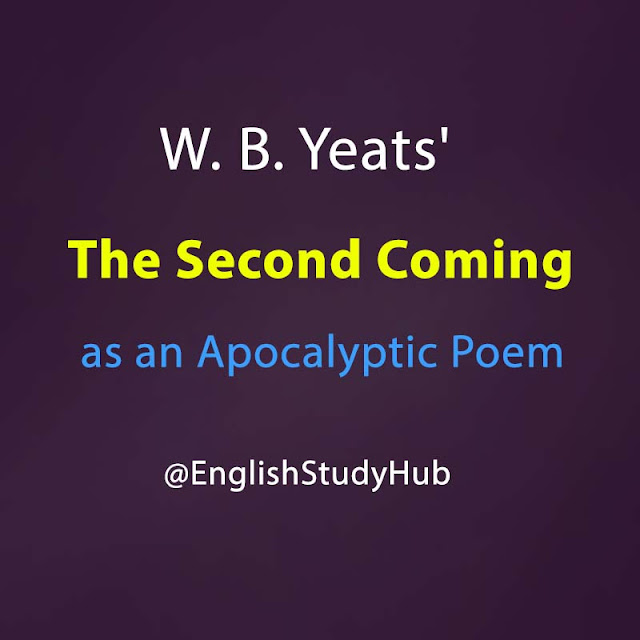W. B. Yeats' The Second Coming as an Apocalyptic Poem
W. B. Yeats’ “The Second Coming” (1921), as a modern poem, is viewed as the most vivid record of momentary prophetic insight in a chaotic world. An analysis of The Second Coming summary and the Second Coming poem analysis shows that it is an archetypal pattern of horror vision of destruction which exposes poet’s political wordiness through an exceptional and visionary masterful art. The poem predicts the close of the Christian era and the arrival of the new age, an age of political upheavals. The poet also suggests that after the numbers of anarchy the beast of apocalypse will arrive, as the revelation is near at hand. So, the poem blisters with apocalyptic ominous visions and consequently The Second Coming is studied as an apocalyptic poem.
The Second Coming as a modernist poem portrays, in the very beginning, the contemporary situation of the modern world through a metaphorical and allegorical description of the landscape of falcon. It flies off from poet's eyes. The symbolic image of the falcon has lost its touch with the falconer. It seems to represent the humanity which has become detached from the falconer. The falconer may be the Christian belief or society which can no longer hold the order in this modern world. The poet utters ---
“Turning and turning in widening gyre
The falcon cannot hear the falconer”.
The Second Coming as an allegorical poem compares the human civilization with the rotating “gyre”. Here the poet actually implies his personal views of history which is explained in his book A Vision. Gyre actually indicates the “spirals”. It exemplifies the cyclical translation of Yeats' history by focusing on the mystical theory of the universe or cosmology. The theory of history centers on a diagram made of two conical spirals. The widest part of the gyre rings around the narrowest part of the other spirals. Yeats believes that each gyre demonstrates a specific historical period or psychological phases of individual development. The world is on the threshold of apocalyptic revelation.
Richard
J. Finnerman quotes Yeats’ own notes:
“The end of an age, which always received the revelation of the character of the next age, is represented by the coming of one gyre to its place of greatest expansion and of the other to its place of greatest contraction. The revelation that approaches will ---take its character from the country movement of the interior gyre.”
In addition to this, the poet intends to show the collapse of the modern society in the beginning of the 20th century. He literally witnesses the “the blood dimmed tide” around the world which strengthens the continuous movement. Through the falconer, the centrifugal force is generated. Things are falling apart and anarchy is losing upon the world. The archetypal myth of flood intensifies terrible the situation in post-war Europe. This flood is drowning the innocence. It is mentioned that---
“Mere anarchy is loosed upon the world,
The blood-dimmed tide is loosed, and everywhere
The ceremony of innocence is drowned”.
Besides, the poet foresees the rise of ominous evil. For instances, Nazism Adolf Hitler who is an egocentric dictator, and Fascism of Benito Mussolini, another diabolical dictator, are mentionable. Yeats observes the brutality and inhuman cruelty during the World War I which has shaken the belief of the modern people. Europe is on the eve of disorder and dread horror in keeping with the historical cycle. The whole world is on the point of destruction. The political disturbance and the tide of violence have destroyed the purity of innocence. Yeats mourns over the fact that the best people have become silent and resigned their fate to the pernicious evil. That’s why the poet frankly remarks that---
“The best lack all, while the worst
Are full of passionate intensity.”
Moreover,
in the second half of the poem Yeats looks beyond the present into the future.
He believes that this chaos cannot be utterly accidental, it must be a
part of the apocalyptic proportions. It must be a second coming or the
revelation that is predicted in The Bible. Yeats envisions that historical
cycle is going to be altered very soon. The poet here shows the
anti-Christ imagery that the revelation would not be the rebirth of Jesus
Christ, as a Messiah, the deliverer of human being, rather it would be rise of
ominous evil. The poet mentions that---
“Surly some revelation is at hand;
Surely the Second Coming is at hand”.
However, the visions of doomsday depict the chaotic atmosphere and political unrest which split the norms of social framework and old tradition. The poet opines that it will not bring the earthly peace. But it will arouse the constant terror of fear among people. The annihilation of war stubs people at broad loss of human life due to the evil power mongers. That’s why the poet provides a glimpse into the nature of the next world through the following lines---
“Troubles my sight: somewhere in sands of the desert
A shape with a lion body and the head of a man,
A gaze blank and pitiless as the sun,”
The poet visions that an
ugly beast, like Sphinx in mythology, a half human and half beast, is
approaching towards Bethlehem, the birth place of Christ. He is worried about
the “vast image out of Spiritus Mundi”, a collective soul or
consciousness of the whole universe. In this surreal dream state, he observes
the ugly creature that frightens the “desert birds”. The poet quotes that---
“Is moving it’s slow thighs', while about it
Reel shadows of the indignant desert birds.”
The
fearful image of the birds shows the indignant of modern people towards
unhealthy and precarious condition of the world.
Ultimately, the poet also believes that the antithetical beast foreshadows the desecration of holy place, Bethlehem. Ironically, it opposes to the Christian belief. Yeats believes that a disorder would replace the Christian civilization. The great demon will arrive with a great terror and it will reverse the “twenty centuries of Stony sleep”. The arrival of a rough beast will be a dramatic incident as the birth of Jesus Christ was to the Old Pagan or classical era. Yeats holds the belief as well that a historical cycle of two thousand years has come to an end. So, it’s now time of final decades with chaos, bloodshed, and the reversion of values. A collapse is coming which is full of uncontrollable burst of fury, war and violence. The poem concludes with a final question which perplexes the reader's mind for an optimistic hope for future generation. He utters ---
“And what rough beast, it’s hour come round at last,
Slouches towards Bethlehem to be born?”
In a nutshell, it would be interesting to remark that the poem ends where it
begins, in gaze of ominous foreshadowing, the specter of looming monster of the
future rapidly approaching. The universe is spinning and growing into
something different than before. The poem remains extremely obscure whether the
future would be an evil mess of chaos, or whether it would offer some sort of
freedom and possibility, it remains undecided. In a word “The Second Coming” is
a magnificent statement on the contrary forces in historical cycle, and
about the conflict between the modern world and the ancient world. Ultimately,
the poem, thus, exposes poet's mystic vision about the occultism and doomsday
of the universe.



Comments
Post a Comment